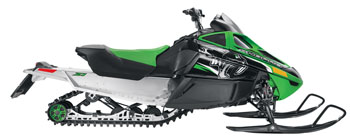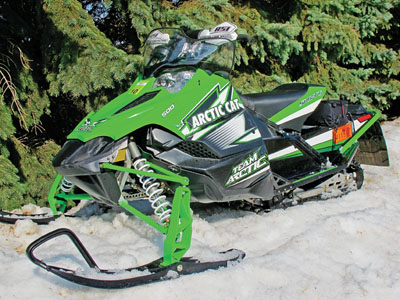Review: 2008 Arctic Cat F1000
Arctic Cat released its F1000 to bold fanfare. Loyalists to the Thief River Falls, Minnesota, company were waiting for it to build an answer for the top-power class being dominated by Ski-Doo’s Mach Z. We left last spring’s testing not having a good feel for the F1000’s potential.
We were growing impatient waiting for our F1000. It was one of the sleds in our fleet last year that we were most eager to ride. We were not able to take delivery of the machine until January last year, because we waited nearly a month while the machine was at the dealer awaiting an “update,” which was kept a secret from us because we are “magazine guys,” the dealership told us.
New for 2008 is a fuel mapping update that improves running quality from what we had in 2007. As for the running quality of our 2007, it was fine — leaving us to speculate whether we had secretly been given an early chance to test the 2008 ignition and fuel mapping. We had massive torque and smooth power — we just wanted more of it.
It’s a bizarre request, really, for anyone to want more power than this stock big bore can dish out. However, we were expecting a strong hit of thrust in the rev range some place that never materialized. Cat usually has something like a taunting snarl in its power delivery that the 999cc twin lacks despite its 165 hp claim. The ZR 900 had a more enthusiastic engine to power around on frozen turf, for example. The heavy Twin Spar chassis only compounds the lack of spirit in the engine.
Like other big-bore twins, the F1000 has its share of vibration. Though they look nice and fit and finish on the new F-Series is top notch, the amount of plastic parts make vibration all the more noticeable.
We made our F1000 faster with an arsenal of speed tricks. This included a Y-pipe and clutch mods from D&D Power Sports of Lowville, New York, different gearing from the folks behind the Diamond Drive, four BullsEyes were added to the intake and we also got a 14-inch wide track from Cat, which is a dealer-available option.
Ride comfort was exceptional. The ride quality from the Twin Spar chassis is best-yet status from Cat. The suspension wasn’t what we’ve grown to expect on Sno Pro models. Traditionally, we’ve sacrificed small bump comfort for big-bump performance. The calibration of the Sno Pro makes it a comfortable sled for either condition with the added benefit of being more plush (not to be confused with mushy) than any Cat before it.
One of the reasons the machine was so inviting was because of its accommodating ergonomics package. The F-Series Sno Pro models come with the Infinite Rider Position system that includes an adjustable seat and adjustable bars. Adjustments were fantastic. Two members of our staff, in particular, differ by five years, 3 inches in height and about 40 pounds. Despite having similar riding styles, each had his own version of a dialed-in cockpit and appreciated the ability to make the change.
We’ve commented every time during a Twin Spar write-up that the chassis has a light steering effort. Some of it seems to be a light touch on the ground, where the machine pushes some during cornering.
 Because we missed the first half of the season with this machine, we only put 791 miles on it. We had one issue with a blown belt that made the typical service significantly more expensive. When the hoop detonated, it took out the reverse system’s shift actuator motor that makes the sled switch gears. Fortunately for us, the belt let go while we were going forward.
Because we missed the first half of the season with this machine, we only put 791 miles on it. We had one issue with a blown belt that made the typical service significantly more expensive. When the hoop detonated, it took out the reverse system’s shift actuator motor that makes the sled switch gears. Fortunately for us, the belt let go while we were going forward.
Editor’s Note: Every issue of Snow Goer magazine includes in-depth sled reports and comparisons, aftermarket gear and accessories reviews, riding destination articles, do-it-yourself repair information, snowmobile technology and more! Subscribe to Snow Goer now to receive issues delivered to your door 7 times per year for a low cost.






